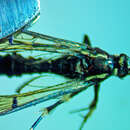Conservation Status
provided by University of Alberta Museums
Uncommon in Alberta. A well-known economic pest of peach trees in eastern North America.
- license
- cc-by-nc
- copyright
- University of Alberta Museums
Cyclicity
provided by University of Alberta Museums
Adults have been collected in Alberta in July.
- license
- cc-by-nc
- copyright
- University of Alberta Museums
Distribution
provided by University of Alberta Museums
Widespread in the eastern half of North America, from Nova Scotia to Florida and west to Manitoba and Minnesota and Texas. It has also been collected recently in the Edmonton area.
- license
- cc-by-nc
- copyright
- University of Alberta Museums
General Description
provided by University of Alberta Museums
"A small (1.7-2.5 cm wingspan) wasp-like diurnal clearwing moth. The antennae, head, thorax, body and legs are mostly blue-black, with some pale yellow and white scaling on the head and palps, the tegulae, and abominal segments one and two (pale yellow laterally) and ventrally on the posterior of segment four. Anal tuft blue-black with a trace of white on the margins. The wings are mostly hyaline, with a faint amber tint in many specimens, very narrow dark margins (including fringe), and a well marked discal bar. Male genitalia has a greatly reduced crista sacculi only slightly visible near the ventral margin of the valve. Males are easily separated from similar S. fatifera
by the all black antennae (apical one-third white in fatifera) and from other similar Alberta species by the small size and very narrow wing margins.
"
- license
- cc-by-nc
- copyright
- University of Alberta Museums
Habitat
provided by University of Alberta Museums
Woodlands and gardens with fruit trees and shrubs such as cherry, saskatoon and other Rosaceae.
- license
- cc-by-nc
- copyright
- University of Alberta Museums
Trophic Strategy
provided by University of Alberta Museums
Larvae bore beneath the bark of the limbs, trunk and occasionally in the roots of Rosaceae, including cultivated peaches, plums and cherries (Prunus sp.) as well as native cherries (Prunus), Saskatoon (Amelanchier) and others. They apparently prefer parts of the hosts with injuries or abnormalities, such as black-knot fungus knots on chokecherry.
- license
- cc-by-nc
- copyright
- University of Alberta Museums

